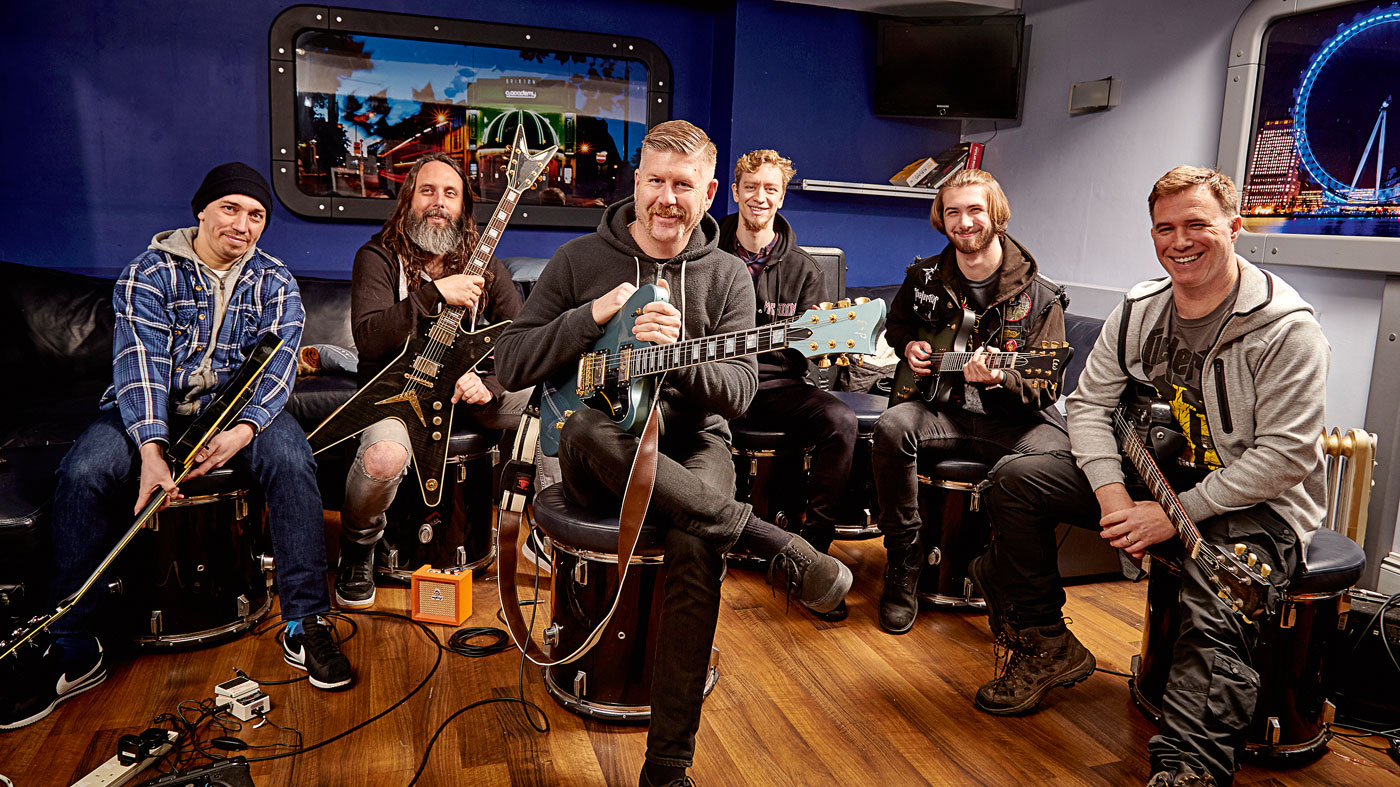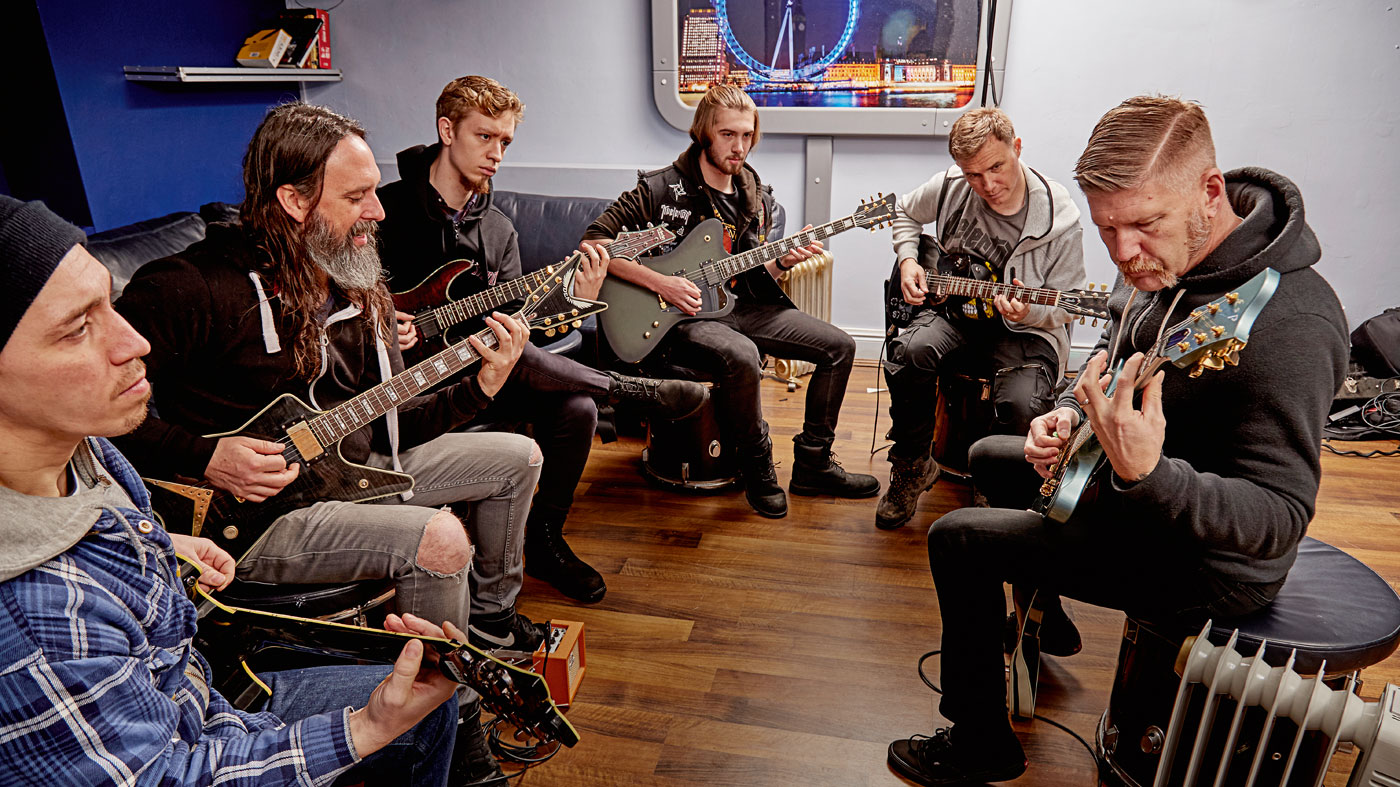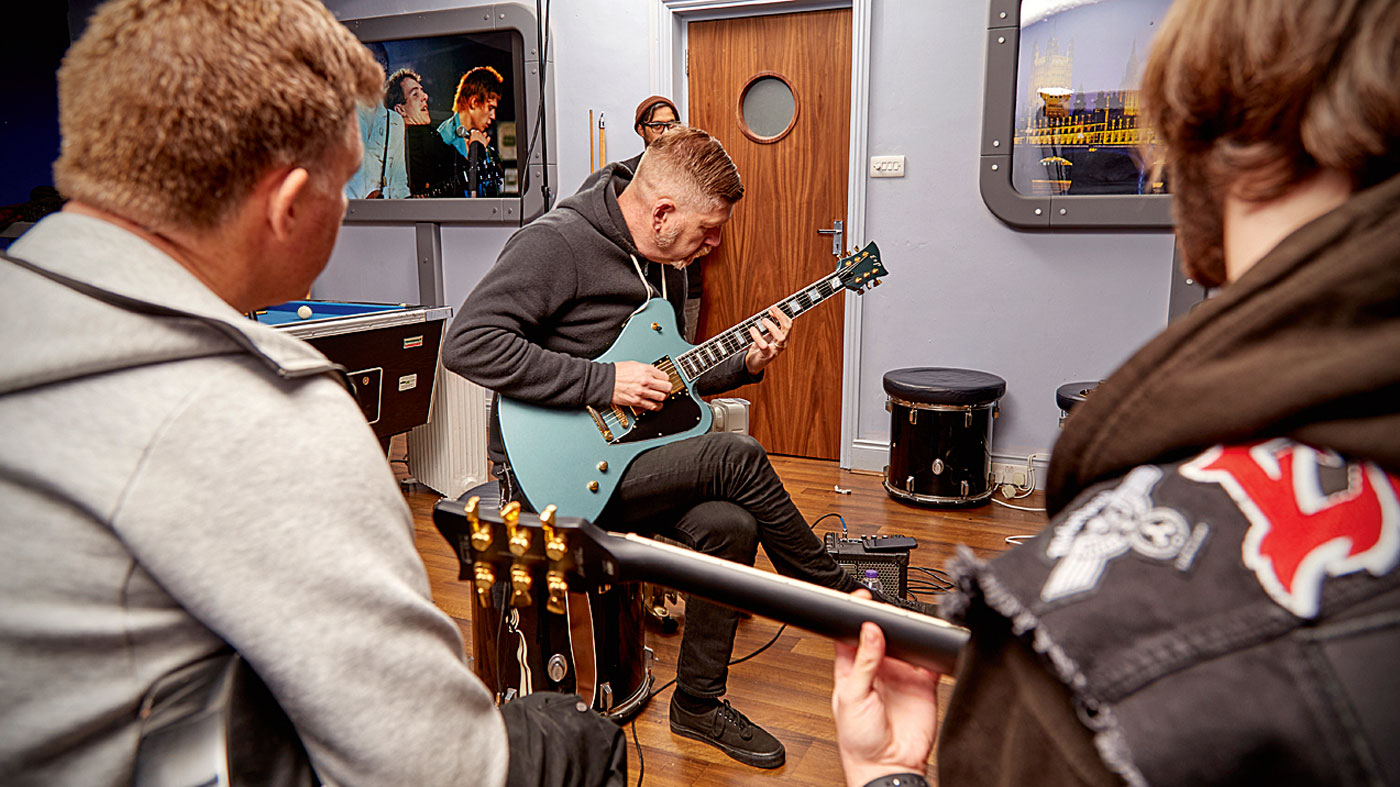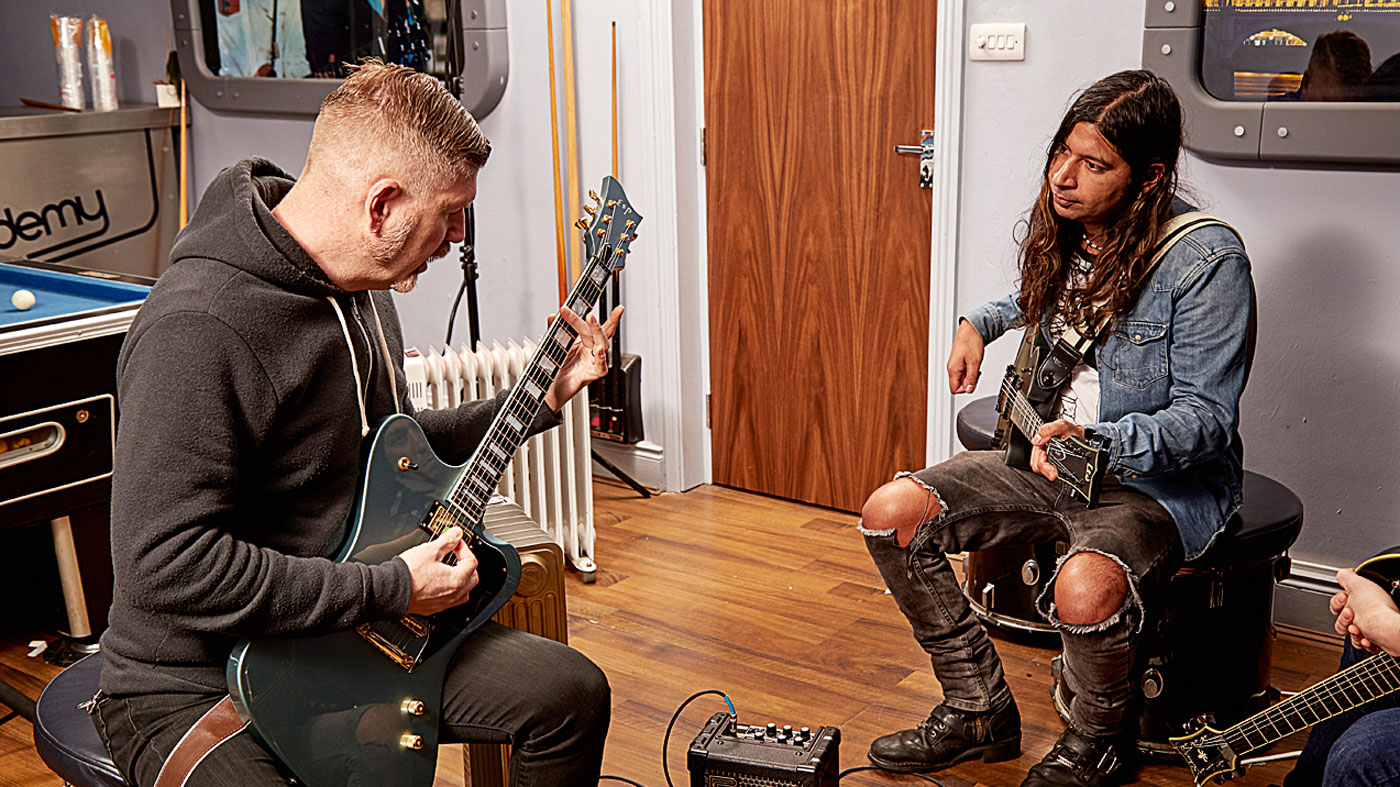Mastodon's Bill Kelliher: “Guitar is less intimidating when you can see patterns - that’s what scales are for”
Access all areas at the metal riff-master's sold-out, preshow guitar clinic

It’s midday at the O2 Academy in Brixton and 10 guitarists shuffle into a room, masterclass tickets in hand and their instruments on their backs. They congregate around Bill Kelliher as for the next hour or so they’ll be taking part in a masterclass the Mastodon man is hosting.
They pick his brain on technique, songcraft and everything else that’s made the Grammy award-winning Mastodon one of the biggest rock bands of their generation.
After lessons are learned and guitars are signed, we grab a coffee with the axeman and explore how some of the patterns he’s been teaching helped him envisage “the roadmap of the neck” that created a fertile breeding ground for brilliantly unorthodox riffs.
How did you first get into teaching guitar?
The people that benefit the most are the ones actively looking for a different way of playing
“I was sitting around backstage and saw someone had written to me asking if I taught. Eventually, I thought I’d put an ad up on Facebook and see if other people were interested. I didn’t know how to go about it or what to charge or if I’d even like it.
“The first one I did was on the Kvelertak/Gojira tour four years ago and I was terrified somebody would come along that was wickedly good and blow me out of the water: ‘What are you gonna teach me, man… I can already play fuckin’ everything!’
“Playing guitar is still an old-fashioned thing, you have to put the hours into practising. The people that benefit the most are the ones actively looking for a different way of playing. We all get complacent at some point and it gets harder to think out of the box. That will show in your writing, you will always write in the same spot. I need some sort of shock, something to make me think outside of the box.”
Get the MusicRadar Newsletter
Want all the hottest music and gear news, reviews, deals, features and more, direct to your inbox? Sign up here.
You started with some often-neglected points on posture…
“Early on, we’d play an hour’s worth of music a night and every song would be 13 different riffs in a row. Afterwards, I’d be crippled. My carpal tunnel was hurting and it was because I was holding the guitar incorrectly. So when I’m teaching anyone how to play, the first thing I have to point out is if they’re not holding the guitar correctly or their hands aren’t in the right places.
“The exercises I came up with, though I didn’t invent them or anything, should help people get their fingers in the right places. You have to challenge yourself if you want to learn something new. It takes time to learn every fingering.”

Diminished returns
So where do you find most players are going wrong?
“A big mistake people often make is trying to add too many notes and over-complicating their ideas. I always try to tell people that it’s best to come up with a simple rhythmic idea and then paint in the higher notes to make these tiny adjustments into new chords, using notes a semitone out. That can make all the difference to a song. It’s not about how fast you play.
A lot of guitar playing is thinking about your next move and your brain thinking fast until it becomes muscle memory
“A lot of people just know scales. Look at Joe Satriani or Steve Vai: they’re both insane guitar players, but I went to see Satch once and I got bored after a couple of minutes. All he did was shred through scales constantly. I guess it sounds cool if you’re into it, but I was thinking, ‘Play a goddamn riff!’ I guess that makes me a riff guy, haha.”
The first exercise was a picked diminished pattern, which is a scale Mastodon have used a lot of over the years…
“Yup, it’s from the same family of chords as the opening riff to Andromeda and more. I found if you keep one finger over each fret, you will kinda have to correspond in the right way. It’s not about looking at the dots, that might confuse you! I see that pattern in my head, a lot of guitar playing is thinking about your next move and your brain thinking fast until it becomes muscle memory.
“On the way down I think about my pointer finger and back up it’s about where my pinky lands. I spent a long time not knowing how to do this stuff backwards and forwards until I realised, ‘You’re a guitar player - figure it out!’ This will make you practise that idea of looking ahead.”

Slaying scales
The legato version was a great workout too…
“It’s like doing push -ups for your pinky because of the doubled notes. If you hammer-on the whole way up, you are only picking one time - it’s the pinky doing the work. And on the way back up, you do it using pull-offs, starting with the pinky. It’s a forward/backwards kinda thing that’s really cool. Then learn how to do it with hammer-ons and pull-offs alternating on each string - that will make you think, for sure! Ideas like this get me excited about guitar, even if I’m just warming up, but it’s changed my writing, too.”
It’s about thinking outside of your Mary Had A Little Lamb major scale or boring pentatonics
How so?
“It’s about thinking outside of your Mary Had A Little Lamb major scale or boring pentatonics. Those mini scales sound good in metal, but they also help me write because they provide a roadmap of the neck.
“This one starts with the middle finger and you can just keep climbing up chromatically. They’re all pretty simple when you break them down into a 1, 2, 3 motion… that’s all it is and you just keep sliding up one fret. It’s good to remember when you get to the second string, you always have to compensate.
“Similarly, there’s the other shape which is a cool-sounding scale; it’s almost like the more you climb, the more you have to think. It’s less intimidating when you can see patterns and that’s what scales are for. And anything that helps me write is very important to me… that’s my job at the end of the day!”
You were also showing students something you called the ‘Slayer scale’...
“I called it that because it has that evil Seasons In The Abyss type of sound and adds in the ring finger. It starts off like a powerchord and I pick it down, down, up. It’s another thing that forces you to think and hit the right notes in time, but after some practise it’s almost like walking down the staircase.
“Same goes for the other economy-picked exercise, which I like the staccato feeling of. It really helps keep you in time and sounds cooler and cooler the faster you play it. I never practise with a metronome, but if I did it would probably make practising a lot cooler!”

Get rhythm - first
It was interesting how you said a lot of your ideas, even the more complex ones, came from a simple rhythmic structure first.
“I can’t stress the importance of rhythm enough. For me, it’s better to get a cool rhythm going and then figure the notes out later when you think about what emotion you want to convey to the listener. Is it super-evil? If not, use it as a stepping stone to your next idea, and eventually you’ll have 123 different riffs at your disposal. It’s like a painting: you start with an idea, which is a rhythm, and then you use musical pencils to draw your idea.
For me, the sketch is the root notes and the melody is how you fill it out
“For me, the sketch is the root notes and the melody is how you fill it out, where the emotion of the song comes from. Listen to the intro to Blood And Thunder, which Brann [Dailor, drums] actually came up with… but he didn’t write it on guitar, he just hummed me the riff, haha! It has to have that rhythm otherwise it completely loses its feel.
“I had the intro for Sultan’s Curse in my head for years but it went into something else that wasn’t as good and too off-time. Eventually, I figured it needed to keep the same rhythm but find different notes, something a little smoother for the chorus. When we first started, everything had to be about sick riffs constantly and a lot of notes, and now we’re more into the idea of allowing our music to change.”

There’s a lot of open-string dissonance to your riffs, bringing not only interesting clashes but also unusual tones sonically.
“Those open strings give you an extra bell to your tone. And as for the clashes, it’s almost like early Helmet - music that keeps you waiting for something to happen. ‘Is it this chord or that chord?!’ Going major to minor can sound like total distress… something happened to Timmy, haha!
“Barre chords should be perpendicular across the fret and it’s good to deconstruct them and arpeggiate them into melodies using extra notes or open strings, like in the half-time middle section of Sultan’s Curse or Roots Remain.
“It’s probably stuff your guitar teacher might say isn’t a chord, but to my ears it’s more about how you lead into it. I never took any lessons, so nothing ever sounds that bad to me! Those parts often sound like The Beatles’ riffs… who would have thought?! Actually, The Beatles had some evil shit going on!”
Is there anything else that’s helped when you’ve hit a creative roadblock?
Sometimes when I get stuck on a song, I’ll change tuning. New shapes for every chord will start bringing you new ideas
“Sometimes when I get stuck on a song, I’ll change tuning down to drop C. New shapes for every chord will start bringing you new ideas, moving them around and adding extra notes. It can lead you down another wormhole of creative thinking.
“Roots Remain was one of the first songs I wrote for the last record and it follows that concept, moving one shape around, but then we got a bit stuck. I decided to make it change to a different key, so I moved down a half-step and I do that a lot when I hit a wall. It’s the same tempo but changes gear into half time.
“At first I kept putting too many notes and then I realised to stick with the chords, but that sounded too much like Deftones - it was very close to one of their songs. So then I thought where the notes would go, to give it that emotion.
“I came up with a lot of new chords on this record just through trial and error like that. The arpeggiated bits sounded cool until I realised I had to be able to stand up and play them, haha! It was easy enough sitting down, which says a lot about why posture is so important!”
Amit has been writing for titles like Total Guitar, MusicRadar and Guitar World for over a decade and counts Richie Kotzen, Guthrie Govan and Jeff Beck among his primary influences. He's interviewed everyone from Ozzy Osbourne and Lemmy to Slash and Jimmy Page, and once even traded solos with a member of Slayer on a track released internationally. As a session guitarist, he's played alongside members of Judas Priest and Uriah Heep in London ensemble Metalworks, as well as handling lead guitars for legends like Glen Matlock (Sex Pistols, The Faces) and Stu Hamm (Steve Vai, Joe Satriani, G3).
“Built from the same sacred stash of NOS silicon transistors and germanium diodes, giving it the soul – and snarl – of the original”: An octave-fuzz cult classic returns as Jam Pedals resurrects the Octaurus
“A purpose-built solution for bassists seeking unparalleled sound-shaping capabilities”: Darkglass Electronics unveils the Anagram Bass Workstation – a state-of-the-art multi-effects for bass guitar with neural amp model support and a 7” touchscreen












